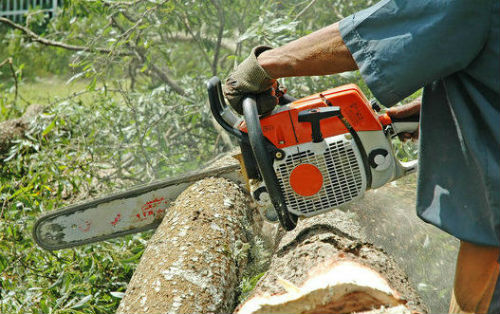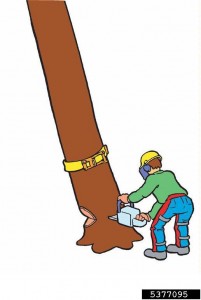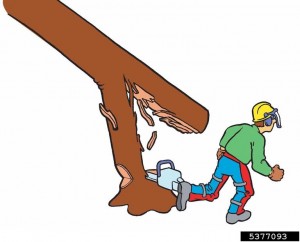
Cutting down a tree, or felling a tree, is generally something that should be left to the professionals. If the tree that you’d like to remove is relatively short and small, however, it may be possible to tackle the task yourself. Whether it’s a tiny tree or a massive one, you need to keep safety in mind at all times. You also need to be clear about how to cut down the tree efficiently and effectively. Basic tips and instructions for cutting a tree are highlighted below.
Tree Cutting Equipment
Before getting down to business, assemble the tools and gear that you’ll need. At the very minimum, you will need the following equipment:
- Protective Gear – People get injured while felling trees all the time. Reduce the risk by wearing Kevlar leg coverings, a hard hat, steel toe boots, heavy-duty gloves and goggles.
- First Aid Kit – In case something goes awry, have medical supplies readily available.
- Chainsaw – Make sure the chainsaw has a sharp chain, a full tank of oil and gas and that it works properly.
- Ladder
- Rope
- Ax
- Wedges
Examine the Tree First: 4 Questions to Consider Before Cutting a Tree
 You’ll have an easier time cutting a tree if you’ve taken a good, hard look at it. Answer these questions before you start:
You’ll have an easier time cutting a tree if you’ve taken a good, hard look at it. Answer these questions before you start:
- Does it lean in one direction or another?
- Are there dead or broken branches?
- Is there a clear area where it can safely fall without damaging anything?
- Are branches from a nearby tree in the way?
While you’re at it, figure out a quick and easy escape route. If things don’t go as planned, you need to be able to get as far away from the tree as quickly as possible. Ideally, you should try to run behind another tree if the tree you are cutting doesn’t fall like it should.
Steps for Cutting Down a Tree


Follow these steps to increase the safety and efficiency of your tree-cutting experience:
- Sound it Out – Knock against the tree with your ax. If it sounds hollow, it may be dead or dying. If it sounds solid, it is live wood and will be more difficult to cut. Do this at different points and heights. With any luck, you’ll find a spot that will make the cutting a lot easier.
- Figure Out Where it Will Fall – Does the tree have a tendency to lean one way or another? It’s easiest and best to choose a drop zone that falls where the tree naturally wants to land. Try to choose a spot that is level, or the tree could roll, bounce or otherwise move and cause damage or injuries.
- Make a Horizontal Cut – This cut should not be higher than your hip, and it should extend no more than one-third of the way into the tree. Keep in mind that the tree will fall perpendicularly to this horizontal cut.
- Make a Wedge Cut – The slice that is produced by this cut should look like a slice of orange. Whether you make it from the top or bottom of the horizontal cut, put a stick on the other side of the horizontal cut to ensure a straight wedge cut.
- Make a Back Cut – This cut will determine how thick your holding wood is, which is the piece that will determine how the tree will fall. Try to make it as thick as possible. Figure out where you want the back cut to terminate and mark it on the tree. It should be at least 1.5 inches above the horizontal cut for best results. As you cut, place a wedge to prevent the tree from settling onto the chainsaw.
- Be Ready – As your back cut is completed, you should end up with an even holding wood. Either that, or the tree will begin to fall. Keep adding more wedges as necessary. Be ready to run at any moment.
- Run – When the tree is on its way down, use your escape route to get safely clear of it. Don’t turn your back on it. By keeping your eye on the falling tree, you can dramatically reduce the risk of being seriously injured.
Tree Cutting Prices & Costs Guide
It’s almost always best to hire a professional company to cut down a tree for you. Before doing so, you should educate yourself about typical tree cutting prices. The cost to cut down a tree depends on a variety of different factors. You can spend as little as $125, or you could end up spending around $1,500 or more. Read our Tree Cutting Pricing Guide and learn more how much it costs to cut down a tree.
Cutting Tree Roots
It is generally recommended that you do not cut a tree’s roots, and this is something that should only happen out of necessity. Some situations in which cutting a tree’s roots may be warranted include the following:
- When a tree is growing too large for the yard in which it is located or
- When a tree is growing dangerously close to the foundation of your home.
There is no way to guarantee that you won’t damage the tree by cutting its roots. If you do, you will more than likely have to remove the tree entirely. Step-by-step instructions for cutting tree roots as safely as possible are highlighted here.
Tree Cutting Techniques & Tips
Cutting down a tree can be dangerous, so it is almost always recommended that you hire a properly trained and equipped professional whenever possible. If you are unable to hire a professional tree service or arborist and need to fell the tree yourself, then these tree cutting techniques may help things go more smoothly.
Before getting to work, make sure that you’re actually allowed to perform this work yourself. In many jurisdictions, laypeople are not allowed to fell trees themselves. If you run afoul of a local ordinance, you could end up facing a fine. Remember that even trained professionals put themselves in harm’s way when they fell trees, so you should probably just hire someone that knows what they are doing. The risks generally outweigh the benefits in this case.

Skip Bauman
Need a pine tree cut and removed in Summerville.
Berta
I need to cut few trees in my house in Brooklyn I need someone to do it for me
Mario Cabrera
need to bring down a few trees, please reply
Vimal
We need to remove dead tree from our backyard. need to know cost.
salma
i have a tree trunk lying in my back yard ,how much does it cost to remove that trunk from there.